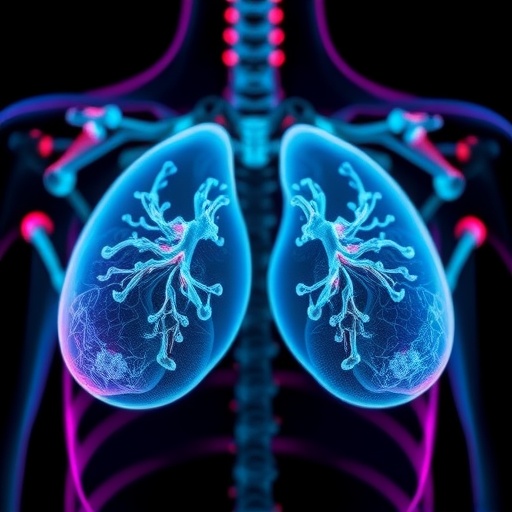In a groundbreaking leap forward for oncological research, scientists are now harnessing the power of 3D bioprinting to unravel the complex biology of breast cancer, heralding a new era in personalized medicine and therapeutic development. This innovative technology promises not only to revolutionize the way we model tumor progression but also to refine drug efficacy testing, ultimately paving the way for treatments tailored to the unique architecture of each patient’s malignancy.
3D bioprinting, an advanced fabrication technique that allows precise placement of cells, matrices, and biomolecules in three-dimensional space, has evolved from a conceptual novelty to a practical tool with profound implications for cancer research. Unlike traditional two-dimensional cell cultures, which fail to mimic the intricate tumor microenvironment, 3D bioprinted constructs faithfully replicate the spatial heterogeneity, cellular interactions, and mechanical properties of breast tumors. This fidelity is crucial for understanding tumor behavior as it unfolds in the human body.
At the core of this breakthrough is the synthesis of patient-derived cells embedded within bioinks—specialized hydrogels containing living biological matter—that serve as scaffolds enabling tissue-like structure formation. Researchers have optimized these bioinks to support cell viability and function, simulating extracellular matrix components and mechanical stiffness typical of breast cancer tissue. This approach facilitates the reconstruction of tumor niches with unprecedented precision, thereby enabling in-depth exploration of cancer cell proliferation, invasion, and drug resistance mechanisms.
The integration of multi-cellular populations within 3D bioprinted models further enriches their relevance. By incorporating cancer-associated fibroblasts, immune cells, and endothelial cells alongside malignant epithelial cells, scientists recreate the intricate crosstalk that orchestrates tumor progression and metastasis. This comprehensive ecosystem enables examination of stromal interactions that influence therapeutic response, a factor often overlooked in conventional models.
One of the most remarkable advantages of 3D bioprinting lies in its ability to produce reproducible models that can be replicated across laboratories, thereby overcoming the variability inherent in animal studies and patient-derived xenografts. This consistency is vital for high-throughput screening of anti-cancer compounds, enhancing the predictive accuracy of preclinical trials. The ability to monitor tumor growth in real-time within these constructs using advanced imaging techniques further accelerates drug discovery pipelines.
Moreover, the customization potential of 3D bioprinting allows for the fabrication of tumor constructs that reflect the genetic and phenotypic diversity of breast cancers, ranging from hormone receptor-positive to triple-negative subtypes. This capacity is instrumental in evaluating therapeutic agents against the spectrum of breast cancer presentations, facilitating the identification of subtype-specific vulnerabilities and resistance pathways.
In the realm of precision oncology, 3D bioprinted breast cancer models are poised to transform clinical decision-making. By using samples derived directly from patients’ tumors, clinicians can test the efficacy of various chemotherapy regimens and targeted therapies ex vivo, tailoring treatment strategies with enhanced accuracy. This approach holds promise for improving clinical outcomes and reducing the trial-and-error often associated with cancer treatment.
Beyond drug testing, 3D bioprinted constructs are invaluable for investigating tumor biology at a fundamental level. Researchers can manipulate microenvironmental parameters such as oxygen gradients, nutrient availability, and mechanical stresses within the printed tissue, thus dissecting how these factors influence tumor evolution and metastasis. This capability offers insights into the mechanisms driving tumor heterogeneity and adaptation under therapeutic pressure.
The coupling of 3D bioprinting with cutting-edge genomic and proteomic analyses further amplifies its utility. By integrating omics data from printed tumor models, scientists can correlate molecular signatures with phenotypic outcomes, illuminating pathways of oncogenesis and treatment resistance. This systems biology approach facilitates the identification of novel biomarkers and therapeutic targets.
Importantly, the ethical advantages of 3D bioprinting must not be overlooked. By reducing reliance on animal models, the technology aligns with the principles of the 3Rs—replacement, reduction, and refinement—promoting more humane and ethically responsible research practices. Furthermore, bioprinted models provide a platform amenable to iterative refinement, allowing dynamic adjustments and improvements without the ethical dilemmas posed by in vivo experimentation.
Challenges remain in scaling this technology for widespread clinical application. The complexity of faithfully reproducing the tumor microenvironment in all its physiological intricacies requires continuous advancements in biomaterials, printing resolution, and cell sourcing techniques. Researchers are actively exploring innovations in bioink formulations and co-culture systems to enhance the longevity and functional relevance of printed tissues.
Additionally, integrating vascularization within the 3D printed tumors remains a significant hurdle. Adequate nutrient and oxygen supply is critical for maintaining tissue viability and mimicking in vivo conditions. Recent progress in bioprinting microvascular networks shows promise in overcoming this limitation, enabling more physiologically accurate models that can sustain longer experimental timelines.
Looking ahead, the convergence of artificial intelligence and 3D bioprinting is anticipated to further accelerate breast cancer research. AI-driven design of bioprinted constructs and predictive modeling of treatment response could optimize experimental workflows and personalize therapeutic regimens even more precisely. This synthesis of technologies epitomizes the transformative potential of interdisciplinary innovation.
The implications of these advancements extend beyond breast cancer to a broad array of malignancies and tissue-related diseases. As protocols and technologies mature, the principles demonstrated by 3D bioprinting in breast cancer studies may set new standards for disease modeling and drug development across the biomedical spectrum.
In conclusion, the advent of 3D bioprinting heralds a paradigm shift in breast cancer research. By faithfully replicating the tumor microenvironment and enabling high-fidelity interrogation of disease mechanisms, this technology stands at the forefront of precision medicine. Ongoing refinements and multidisciplinary collaborations promise to unlock new therapeutic avenues and significantly improve patient prognoses in the coming decade.
Subject of Research: Breast Cancer and 3D Bioprinting Technologies
Article Title: 3D Bioprinting Innovations: A New Frontier in Breast Cancer Research
Article References:
Seifi, Z., Khazaei, M., Dayani, M. et al. 3D bioprinting innovations: a new frontier in breast cancer research. Med Oncol 43, 1 (2026). https://doi.org/10.1007/s12032-025-03069-6
Image Credits: AI Generated
DOI: https://doi.org/10.1007/s12032-025-03069-6




